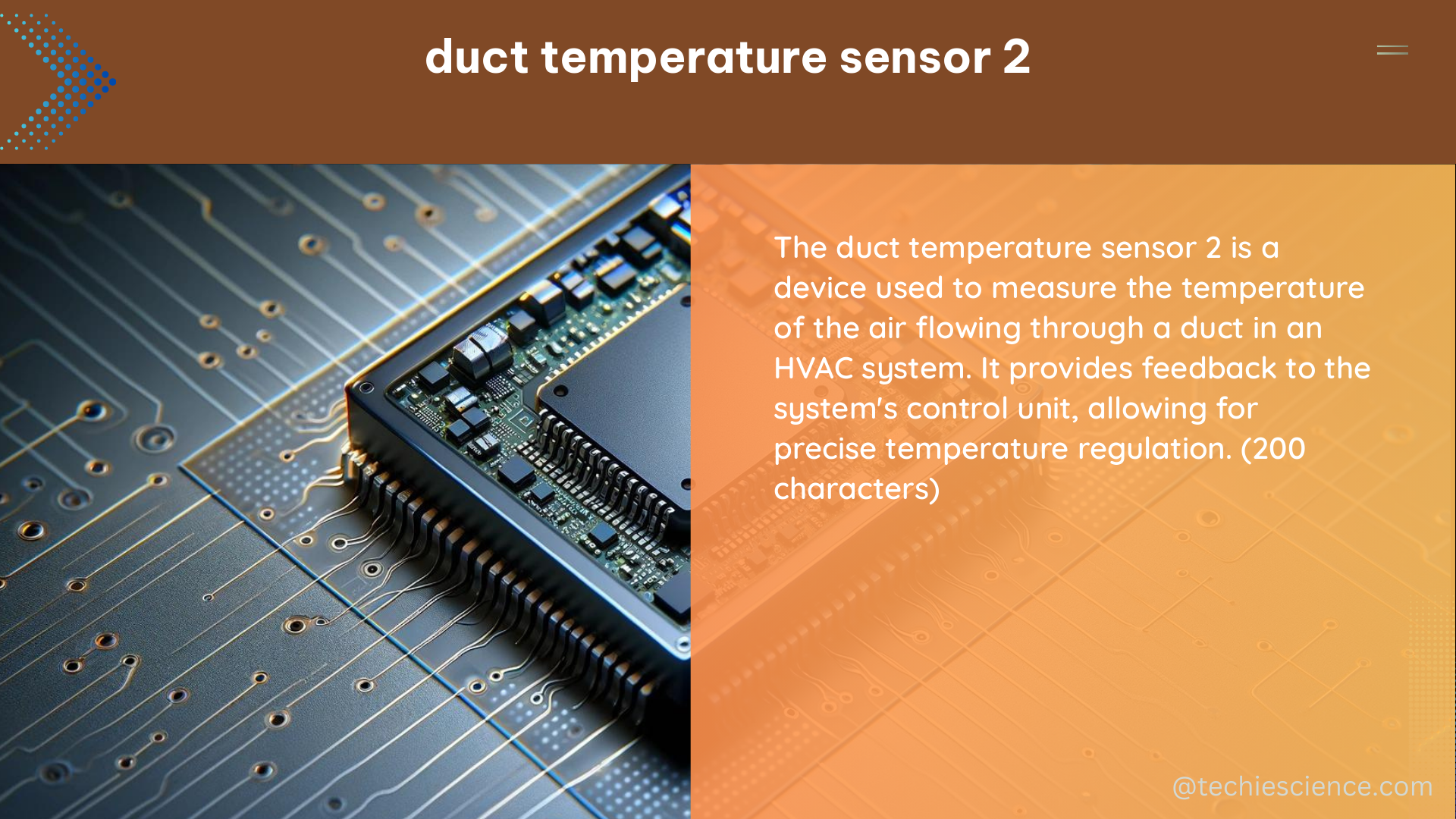The duct temperature sensor 2 is a critical component in HVAC systems, responsible for accurately measuring the air temperature within a duct. These sensors play a vital role in energy management and comfort control, particularly in large commercial and industrial buildings. By providing precise temperature data, duct temperature sensors 2 enable facility managers to optimize the efficiency of heating and cooling systems, ultimately leading to significant energy savings and improved indoor environmental quality.
Understanding the Duct Temperature Sensor 2
The duct temperature sensor 2 typically utilizes a thermistor-based probe to measure the air temperature within a duct. These sensors are designed to provide accurate and reliable temperature readings, often with an accuracy of ±0.2°C (±0.36°F) or better. The sensor’s temperature range can vary, but a common range is -40°C to 120°C (-40°F to 248°F), ensuring it can handle the diverse temperature conditions found in HVAC systems.
One example of a high-performance duct temperature sensor 2 is the Wireless Professional Gen 2 Duct Temperature Sensor from Scigiene. This sensor features an NTC (Negative Temperature Coefficient) thermistor probe with an 8-foot UL-listed plenum cable, allowing for accurate temperature measurements while maintaining a sealed environment within the duct.
Importance of Duct Temperature Sensor 2 Accuracy

The accuracy of the duct temperature sensor 2 is crucial for effective energy management and system efficiency calculations. By monitoring the temperature difference between the supply and return air, facility managers can determine the overall efficiency of the HVAC system and identify potential issues that may lead to energy waste.
For instance, a duct temperature sensor 2 with an accuracy of ±0.2°C (±0.36°F) can provide valuable insights into the system’s performance. If the supply air temperature is measured at 20°C (68°F) and the return air temperature is 25°C (77°F), the temperature difference would be 5°C (9°F). With this information, facility managers can calculate the system’s efficiency and make informed decisions about maintenance, adjustments, or upgrades to optimize energy consumption.
Proper Installation of Duct Temperature Sensor 2
Ensuring the correct installation of the duct temperature sensor 2 is essential for accurate temperature measurements and optimal system performance. The sensor’s positioning within the duct can significantly impact the readings, and specific guidelines should be followed to achieve the best results.
Addressing Duct Stratification
Duct stratification, which refers to the uneven distribution of air temperature within the duct, can significantly affect the accuracy of the duct temperature sensor 2. To address this, the sensor should be installed in a manner that accounts for the type of stratification present:
- Horizontal Stratification: For ducts with horizontal stratification, the sensor should be installed vertically (up and down) across the duct, through the lines of stratified air.
- Vertical Stratification: For ducts with vertical stratification, the sensor should be installed horizontally (side to side) across the duct, through the lines of stratified air.
Determining the Number of Sensor Passes
The number of sensor passes across the duct is another crucial factor in ensuring accurate temperature measurements. As a general rule, it is recommended to have one averaging sensor pass for every 10 square feet of duct size, rounded up to the next pass. For example, a 9’x9′ square duct with a total area of 81 square feet should have a minimum of 9 passes across the duct.
Sensor Placement Considerations
When installing the duct temperature sensor 2, it is essential to consider the following placement guidelines:
- Locate the sensor at least 5 duct diameters downstream from any elbows, transitions, or other obstructions to ensure a fully developed air flow.
- Position the sensor away from direct sunlight, heat sources, or cold air intakes to avoid interference with the temperature readings.
- Ensure the sensor is securely mounted and sealed within the duct to prevent air leaks or temperature fluctuations.
Cost Considerations for Duct Temperature Sensor 2
The cost of duct temperature sensors 2 can vary depending on the manufacturer, features, and specific requirements of the HVAC system. As an example, the Wireless Professional Gen 2 Duct Temperature Sensor from Scigiene is priced at $105, offering advanced features such as a wireless range of over 1,200 feet, a 10-year battery life, and encrypted RF security.
When selecting a duct temperature sensor 2, it is essential to consider the overall value proposition, including accuracy, durability, and compatibility with the existing HVAC system. While the initial cost may be a factor, the long-term benefits of improved energy efficiency and system performance can often justify the investment.
Conclusion
The duct temperature sensor 2 is a critical component in HVAC systems, providing the essential data needed for effective energy management and comfort control. By understanding the importance of sensor accuracy, proper installation techniques, and cost considerations, facility managers can ensure their HVAC systems operate at peak efficiency, leading to significant energy savings and enhanced indoor environmental quality.
References:
- Bringing Automated Fault Detection and Diagnostics Tools for HVAC Systems in Commercial Buildings, ASME Digital Collection
- Veris Industries Catalog
- Veris Industries Mounting Methods and Best Practices for Duct Averaging Sensors
- BAPI HVAC If the new ducts are an extension of an existing duct system, Energy Code Ace
- Wireless Professional Gen 2 Duct Temperature Sensor, Scigiene

The lambdageeks.com Core SME Team is a group of experienced subject matter experts from diverse scientific and technical fields including Physics, Chemistry, Technology,Electronics & Electrical Engineering, Automotive, Mechanical Engineering. Our team collaborates to create high-quality, well-researched articles on a wide range of science and technology topics for the lambdageeks.com website.
All Our Senior SME are having more than 7 Years of experience in the respective fields . They are either Working Industry Professionals or assocaited With different Universities. Refer Our Authors Page to get to know About our Core SMEs.